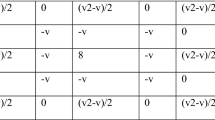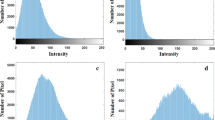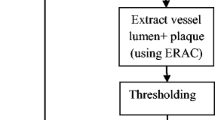Abstract
Purpose
The aim of this study was to develop a method for early, accurate differentiation between old myocardial infarction (OMI) and angina pectoris (AP) using color kinesis (CK) images. We first extracted exact end-diastolic and end-systolic contours from CK images and then extracted the features of cardiac function from two CK images (one at rest, the other after exercise) and investigated their effectiveness in differentiating old myocardial infarction and angina pectoris. We then evaluated the effectiveness of several features in recognizing coronary artery disease and used the effective features to show the differentiation results.
Methods
First, we extracted exact end-diastolic and end-systolic contours from CK images with an active contour model. Second, we defined the features that seemed to be effective in recognizing coronary artery disease. The features are extracted from the region between the end-diastolic endocardial contour and end-systolic endocardial contour in two CK images: one obtained when the subject was at rest and the other after exercise. Nine features were considered effective for differentiating old myocardial infarction and angina pectoris, and the effectiveness in recognizing coronary artery disease, which includes old myocardial infarction and angina pectoris, was evaluated. Third, coronary artery disease is recognized by the effective features.
Results
Contours near a manual trace by a skilled physician were obtained using the proposed method. Multiple comparisons of the mean values of the extracted features were drawn among three groups: a healthy-subject group; an old myocardial infarction patient group; and an angina pectoris patient group. The feature effective in differentiating old myocardial infarction was the “area at rest”; those effective in differentiating angina pectoris were a “decrease in area” and a “decrease in movement.” These effective features have almost always differentiated old myocardial infarction and angina pectoris.
Conclusions
This study used the endocardial contour extraction technique with the dynamic contour model and evaluated the validity of the features of cardiac function; it then recognized coronary artery disease from the effective features. Multiple comparisons of the mean value of the extracted features among the healthy-subject group, the old myocardial infarction patient group, and the angina pectoris patient group has proved that the “area at rest” is effective in differentiating old myocardial infarction, and the “decrease in area” and “decrease in movement” are effective for differentiating angina pectoris.
Similar content being viewed by others
References
V Mor-Avi P Vignon R Koch et al. (1997) ArticleTitleSegmental analysis of color kinesis images Circulation 95 2082–97 Occurrence Handle1:STN:280:ByiB2sfpsVY%3D Occurrence Handle9133519
P Vignon V Mor-Avi L Weinert et al. (1998) ArticleTitleQuantitative evaluation of global and regional left ventricular diastolic function with color kinesis Circulation 97 1053–61 Occurrence Handle1:STN:280:DyaK1c7ovFOguw%3D%3D Occurrence Handle9531252
SL Lin YN Sun CH Lin et al. (2002) ArticleTitleInitial experience of using color kinesis in the diagnosis of coronary artery disease Chin Med J 65 457–67
A Shiozaki T Masuyama K Yamamoto et al. (1997) ArticleTitleKinetic image processing for quantifying ventricle regional wall motion behavior J Med Ultrasonics 24 403
A Nakada A Shiozaki Y Hirano et al. (2002) ArticleTitleDiscrimination of region and name of disease with stress echocardiography by kinetic imaging Trans JSMBE 40 170
T Omori A Shiozaki Y Hirano et al. (2004) ArticleTitleContour extraction of left ventricle from ultrasonic color kinesis echocardiography using active contour model IEICE Trans Inf Syst J87-D-II 1543–6
H Tamura (2003) Computer image processing Ohm Tokyo
Kass M, Witikin A, Terzopoulos D. Snakes: active contour models. Int J Comput Vision 1988;321–31
Sakaguchi T, Oyama K. Snakes with area term. Proc IEICE Gen Conf 1991;D-555 (in Japanese)
S Araki N Yokoya H Iwasa et al. (1996) ArticleTitleSplitting active contour models based on crossing detection for extracting multiple objects IEICE Trans Inf Syst J79-D-II 1704–11
Y Nagata M Yoshida (1997) Foundation of statistical multiplex comparing method Scientist Tokyo
Author information
Authors and Affiliations
Corresponding author
About this article
Cite this article
Shiozaki, A., Omori, T., Hirano, Y. et al. Differentiation of myocardial infarction and angina pectoris by processing ultrasonic color kinesis images. J Med Ultrasonics 32, 49–56 (2005). https://doi.org/10.1007/s10396-005-0033-3
Received:
Accepted:
Issue Date:
DOI: https://doi.org/10.1007/s10396-005-0033-3




